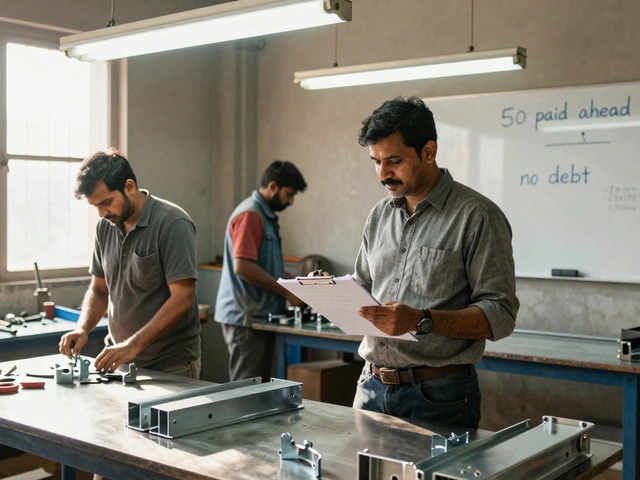Most Digitized Country in the World: What It Means for India's Electronics Manufacturing

If you think being 'digitized' is just about using smartphones, think again. The most digitized countries in the world connect whole cities, run public services online, and streamline factories with real-time data. Sweden, Denmark, and Singapore often fight for the top spot, but South Korea is the one that consistently stuns with its all-in approach to tech. Over 95% of Korean homes have super-fast broadband. Every corner shop can process digital payments. And local factories—some the size of small airports—are run on connected systems that work around the clock and barely need paper.
Feeling behind? Don’t. This level of tech didn't happen overnight. Even South Korea was nowhere on the digital map thirty years ago. Its massive bet on fiber optics, government support for smart manufacturing, and a culture that embraces innovation made the difference. There’s something in this story for India’s electronics manufacturing sector—especially now, when factories here are more connected than ever, and the government keeps pushing Make in India and Digital India together.
- Defining Digitalization: Beyond Just Internet Access
- Who Leads? The World's Most Digitized Country Revealed
- The Digital Edge: Lessons from the Leader
- Where Does India Stand and What’s Changing?
- Takeaways for Electronics Makers in India
Defining Digitalization: Beyond Just Internet Access
Digitalization is way more than just having Wi-Fi at home or scrolling social media. For a country to call itself truly digitized, it has to build tech into every slice of life—public services, banking, education, healthcare, transport, and especially industries like electronics manufacturing. It’s about using digital tools not just for convenience but to actually boost productivity and create new business models.
Here’s what sets apart a digitized country from one that’s just online:
- National digital IDs that let citizens deal with government stuff online—think tax, health, voting.
- Most payments and transactions are cashless, handled by phones or cards.
- Factories use robotics, sensors, and AI to run smarter lines and cut errors.
- Data flows across sectors—real-time weather updates for farmers, online health records for doctors, digital maps for logistics.
- Public Wi-Fi in schools, buses, even in remote villages and city parks.
Check out how this looks in numbers for top digitized countries:
| Country | Broadband Penetration (%) | Digital Payment Adoption (%) | Manufacturing Automation (%) |
|---|---|---|---|
| South Korea | 97 | 98 | 56 |
| Sweden | 95 | 90 | 49 |
| Singapore | 92 | 96 | 52 |
Real digitalization shows up when even the smallest store takes QR payments, hospital records update in real time, and let’s not forget—when factories keep humming through smart systems and IoT gadgets. That’s what makes a nation a true digital powerhouse, not just one with lots of people online.
Who Leads? The World's Most Digitized Country Revealed
If there’s a gold medal for digital dominance, South Korea keeps taking it home. For years, everyone from the United Nations to the World Economic Forum has recognized South Korea as a digital juggernaut. Back in 2024, South Korea topped the International Digital Economy and Society Index, squeezing ahead of tech giants like Sweden and Singapore. Why? Nearly 99% of Koreans are online, and their internet speeds are the fastest on the planet, averaging over 100 Mbps everywhere—even on the subway.
But what really puts South Korea ahead isn’t just fancy gadgets. The country jumped early into fiber-optic networks, poured billions into a digital education push, and encourages cashless transactions almost everywhere. Bank branches? You barely need them—nearly every payment goes through a phone, watch, or card.
It doesn’t stop at consumers. Factory floors in places like Suwon and Ulsan run on cloud software, robotics, and sensors. Samsung’s smart factories are a case study in AI meeting hardware. These sites turn out chips and displays for phones and TVs with barely a hiccup, using live production data to reduce waste and boost efficiency.
For comparison, Sweden scores high for digital public services and Singapore for citywide tech, but South Korea stands out for how digital tools shape everyday life and the whole manufacturing industry. Anyone wondering what a digitized future looks like—especially those interested in electronics manufacturing—should keep an eye on what’s happening in Seoul and Busan.

The Digital Edge: Lessons from the Leader
If you’re wondering how a country cracks the code on total digital transformation, just look at South Korea. Their trick? Not just fast internet, but a whole ecosystem wired for efficiency, innovation, and growth. In most Korean cities, public Wi-Fi is everywhere—subways, buses, parks. Even a local corner shop can scan QR codes or accept payments from every digital wallet in the region. It’s not just about convenience. It’s about a system where everyone from a college student to a big manufacturer gets the same digital tools.
Here’s a snapshot that turns heads: South Korea’s government invested billions in the 2000s to cover the entire country with fiber broadband, making slow internet almost impossible to find. As of 2024, over 99% of households have internet access. Factories are full-on smart—using IoT and AI for everything from inventory to predictive maintenance, which cuts downtime and keeps machines running. Samsung, for example, uses AI-powered inspections that spot microscopic defects in chips miles ahead of human eyesight, boosting yield rates and profit.
- Digital education starts early—kids learn to code and use productivity software from primary school.
- Government paperwork? You barely need to leave home. Most official things—taxes, business registration, healthcare—can be done online within minutes.
- Public safety and traffic use real-time digital data to handle emergencies and keep things moving smoothly.
Let’s break down some numbers. See how South Korea stacks up compared to other players when it comes to hard data:
| Country | Broadband Penetration (%) | Digital Payment Usage (%) | Factories with IoT |
|---|---|---|---|
| South Korea | 99 | 93 | 85 |
| Sweden | 97 | 89 | 78 |
| Singapore | 96 | 91 | 81 |
| India | 62 | 71 | 35 |
The biggest lesson? Going digital isn’t about ticking tech boxes—it’s about making sure the whole country, and especially the most digitized country, goes digital together: families, businesses, and public services. That’s what sparks real innovation. For India’s electronics manufacturing scene, the message is clear: invest in digital infrastructure, upskill the workforce, and automate. South Korea didn’t wait for everyone to be ready—they just made it easy so nobody got left out. That edge is up for grabs for anyone willing to make similar bold moves.
Where Does India Stand and What’s Changing?
India’s digital growth has gone from sluggish to supercharged in just the last decade. A few years back, most people in rural areas struggled with lousy internet, but as of 2025, over 800 million people use the internet in the country—more than the population of Europe. And it’s not just social media. The country is building its own digital backbone, with projects like Digital India and Make in India working hand in hand to push tech into every corner of daily life and business.
The most digitized country in the world still seems out of reach, but India is closing gaps fast. Every electronics manufacturer knows the impact—factories are using more AI and automation, the supply chain is tracked in real time, and mobile payments are everywhere. Even small-town factories have government-backed incentives to get smart machines or train staff for the digital age. By 2023, India hit $6 billion in electronics exports per month, and most of those goods were tracked, packed, and shipped using digital tools.
| Metric | 2015 | 2020 | 2025 |
|---|---|---|---|
| Internet Users (Millions) | 302 | 749 | 830 |
| Digital Payment Volume (Billion transactions) | 1.2 | 34 | 130* |
| Electronics Exports ($ Billion) | 6.0 | 12.1 | 72* |
| Number of Active Smart Factories | 100 | 800 | 2250* |
*2025 numbers are government estimates and industry projections.
So, what’s actually shifting on the ground? Here’s what’s different compared to just five years ago:
- High-speed 5G now covers over half the cities and upcoming industrial parks. This means instant data, smooth remote monitoring, and zero lag for machine-to-machine talk.
- Government-backed PLI (Production-Linked Incentive) schemes offer serious cashbacks and tax breaks to electronics makers who adopt digital tracking and automated systems.
- Email is old news. Today, GST filings, compliance checks, and even export authorizations are all done through connected government portals.
- Digital skills are hot. ITIs and engineering colleges partner with big electronics brands to train young folks specifically for smart factories, robotics, and AI-based manufacturing work.
- Small factories in Tamil Nadu, UP, and Gujarat use real-time dashboards to spot issues on the line and cut down losses, just like their bigger rivals in Bengaluru or Noida.
The extra push from local startups makes a difference too. Homegrown solutions for supply chain, logistics, and factory monitoring now compete with global leaders, so electronics manufacturing gets smarter every year. Sure, India’s not at South Korea’s level yet, but this wave of change is real—and it's picking up speed with every new factory that comes online.

Takeaways for Electronics Makers in India
The most digitized country in the world isn’t just a tech show-off — it’s a handy guidebook for manufacturers looking to win big. The first thing that jumps out is how much tech can trim costs and boost speed on the production line. For Indian electronics makers, this isn’t some far-off dream — it’s happening now with automation, sensors, and real-time monitoring. About 500+ Indian factories, according to a 2024 NASSCOM survey, reported cutting production failures by nearly 30% after rolling out basic digital tools like IoT dashboards and cloud-based quality checks.
Let’s break down what matters most if you’re making electronics in India and want to compete with the global best:
- Go digital with inventory: Build out ERP systems, use connected data to track every nut and bolt, and say goodbye to manual record-keeping.
- Skills matter: Countries like South Korea win because their workforce is digitally fluent. Invest in short, intensive training—think two-week upskilling camps on robotics and data analytics instead of waiting for long engineering degrees.
- Partner smart: Team up with local tech start-ups for AI-powered quality control or predictive maintenance. These solutions often pay off in less than a year.
- Lean on government schemes: Tap into PLI (Production Linked Incentive) and schemes like Digital India that pour money into hardware upgrades and connectivity in smaller cities — don’t ignore the paperwork, the payoff is real.
South Korea’s blueprint shows the power of getting everyone—from big brands to local suppliers—connected and sharing data. Here’s a look at how India stacks up compared to the leader:
| Country | Factory Automation Rate (%) | Digital Payments Penetration (%) | Government Digital Spend (USD bn, 2024) |
|---|---|---|---|
| South Korea | 85 | 97 | 18 |
| India | 34 | 89 | 8.4 |
India’s catching up fast, especially when you look at how digital payments exploded in the last couple of years. But there’s room to grow in factory automation and digital factory spending. Big or small, every manufacturer has to treat most digitized country as a goalpost. Investing in tech isn’t a nice-to-have—it's what keeps you in the game, lets you snag export deals, and future-proofs your business when global competition heats up. The real move? Start small, measure what tech saves you, and scale from there.





